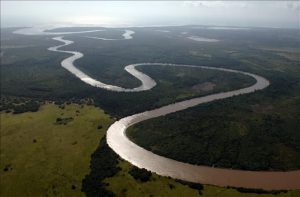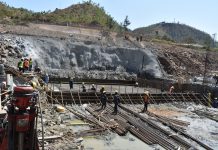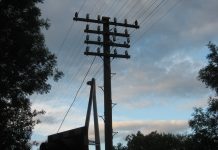Reported by
Faridah N Kulumba
Tanzania’s Julius Nyerere Hydropower Station (JNHS, RHHP, Rufiji Hydroelectric Power Project, Stiegler’s Gorge Dam) is under construction across the Rufiji River in eastern Tanzania by Egyptian contracting sector, after the two countries lay foundation in 2019.
The government of Tanzania approved this controversial hydroelectric dam plan in 2018 after diplomatic negotiation between Tanzania’s president Magufuli and Egypt’s al-Sisi. And Tanzania awarded the design and construction contract for this project to Egyptian companies in the construction sector-Arab Contractors and El-Sewedy Electric after winning the tender that several multinational companies bid on.
But the station is managed by the government owned Tanzania Electric Supply company (TANESCO) and is expected to be completed in 2022.
Nyerere power station is expected to have an installed capacity of 2,115 megawatts (2,836,000 hp) and will produce 5,920wh of power annually.
Over the past month, Egypt and Ethiopia exchanged accusations on the Nile dam dispute, amid verbal skirmishes, and diplomatic moves by officials of the two countries to mobilise international positions in their respective favor.

Background
In 1901 German Engineer Stiegler led the first expedition to what is known as Stiegler’s Gorge to consider potential infrastructure. Stegler, when measuring the Gorge, was charged and killed by an elephant near the ravine in 1907, and it was named after him in his memory.
Plans for a dam were developed during British rule of Tanganyika. In 1938-1929 Alexander Telford conducted the first systematic development surveys of the Rufiji.
Progress
On September 4, 2020, Egyptian prime Minister Mustafa Madbouly issued a press statement saying that President Abdel Fattah al-Sisi tasked the government to complete the construction of the Julius Nyerere dam and hydrpower station in Tanzania to the highest quality.
Nyerere dam is among the largest hydroelectric dams in the East Africa region, and the project is being implemented at a coast of $2.9 billion through a partnership between the Tanzania Electric Supply Company (TANESCO) and the two largest Egyptian Companies.
Egyptian Minister of Housing, Utilities and Urban Communities Assem el-Gazzar praised the progress of the project and the commitment to preventive and precautionary measures to protect and ensure the health and safety of the workers part of it reported Al-Monitor.
The importance of the presence of Egyptian companies in Tanzania
Hani Raslan, founder of the Nile Basin studies department at Al-Ahram Center for political and Strategic Studies, told Al-Monitor that building the Nyerere dam and hydopower station will boost Egypt’s presence in Tanzania, which is one of the Nile Basin countries that Egypt seeks to cement ties with.
Raslan said that implementing such a huge project constitutes a powerful work precedent in Africa, and it helps Egypt to reclaim its soft power in the continent. Egypt’s real gain out of building the dam is to strengthen its relations with Tanzania, in the framework of its plan to support African countries. The building of the dam also aims to encourage the implementation of other projects between the two countries in the fields of electricity and renewable energy.
Egyptian Prime Minister Mustafa Modbouly said that the construction is of the highest quality in order to reflect the ability of the Egyptian contracting sector to implement huge projects.
Economic and political importance of the dam to Tanzania
Tanzania signed a contract with Egypt to establish Nyerere dam, which aims at generating electric power to supply Tanzania’s power for industrialisation and electrification.
Mahmoud Kisinga University Student told Africa-Press in a phone interview that indeed there is a regular electricity crisis in Tanzania most especially during the dry season. “There is always power shortage and load shedding which usually occurs in the dry season, i believe all those problems will be solved once the dam is finished,” Kisinga said. The dam is also constructed to control the water quantities during flood period and providing the Tanzanian state’s water need.
On the political level, Egypt’s real gain out of building Nyerere dam is to strengthen its relations with Tanzania, in the framework of its plan to support African countries. Tanzania has expressed its support for the June 30, 2013, revolution that opposed the Muslim Brotherhood’s rule.
The impact

The head of Nile Water Resources and Irrigation Ahmed Bahaa Eddini, told Al-Monitor that the dam does not have a negative impact on neighbouring countries. “The dam does not affect Egypt’s water quota because it is located on the Rufiji River basin and is far from the Nile River. The Nile Basin riparian countries have a number of river basins,” Eddini said.
Also head of the Arab Water Council and former minister of water resources and irrigation Mahmoud Abu Zeid refuted Ethiopia’s accusations of obstructing development projects in the basin countries to monopolise the largest share water.
“Egypt is strengthening its relations with the Nile Basin countries, by implementing joint development projects for the benefit of their people without harming anyone, and to take advantage of the annual rainwater that is being wasted in most of the countries,” Abu Zeid said.
Tanzania’s government publicly stated that the dam will be financed by Tanzania’s national budget, yet no funding package was announced and the world Bank and other financiers rejecting support for the dam.







